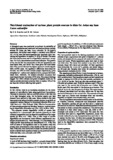We appreciate your understanding and wish you a joyful holiday season!
Growth and survival of juvenile tiger shrimp fed diet where fish meal is partially replaced with papaya (Carica papaya L.) or camote (Ipomea batatas Lam.) leaf meal
| dc.contributor.author | Peñaflorida, Veronica Dy | |
| dc.date.accessioned | 2013-02-26T02:11:35Z | |
| dc.date.available | 2013-02-26T02:11:35Z | |
| dc.date.issued | 1995 | |
| dc.identifier.citation | Peñaflorida, V. D. (1995). Growth and survival of juvenile tiger shrimp fed diet where fish meal is partially replaced with papaya (Carica papaya L.) or camote (Ipomea batatas Lam.) leaf meal. The Israeli Journal of Aquaculture-Bamidgeh, 47(1), 25-33. | en |
| dc.identifier.issn | 0792-156X | |
| dc.identifier.uri | http://hdl.handle.net/10862/1478 | |
| dc.description.abstract | Fish meal is the major protein source in shrimp and fish diets but its continuous use would make it scarce and expensive. There are, however, potential substitutes like soybean or leaf meals. Papaya or camote leaf meals have not been tested as partial replacement for fish meal in diets for tiger shrimp. Thus, two feeding trials were made to test diets with leaf meals against a control shrimp diet. Both experiments used 50 mg shrimp stocked at 10 per 40 liters of sea water following standard water management. Trial 1 had diets containing either 17% soaked or unsoaked camote leaf meal or 16% papaya leaf meal. Results indicated that weight gain, specific growth rate and feed conversion ratio of the unsoaked papaya were similar to the control, higher than the unsoaked camote, but not significantly different (α= 0.05) from the soaked camote and papaya groups. Survival was not significantly different among treatments. Trial 2 used the best diet from Trial 1 - unsoaked papaya leaf meal - at 16%, 19% or 22% of the diet. The weight gain (1846%) of the shrimp fed 16% papaya leaf meal was not significantly different (α= 0.05) from the control 2034% but higher than the 22% group (1535%). Therefore, papaya leaf meal can partially replace (10%) animal protein in shrimp diets and serve as a source of exogenous proteolytic enzyme. However, its efficacy in culturing shrimp in ponds must be tested. | en |
| dc.language.iso | en | en |
| dc.publisher | Society of Israeli Aquaculture and Marine Biotechnology | en |
| dc.subject | Carica papaya | en |
| dc.subject | Ipomoea batatas | en |
| dc.subject | Penaeus monodon | en |
| dc.title | Growth and survival of juvenile tiger shrimp fed diet where fish meal is partially replaced with papaya (Carica papaya L.) or camote (Ipomea batatas Lam.) leaf meal | en |
| dc.type | Article | en |
| dc.citation.volume | 47 | |
| dc.citation.issue | 1 | |
| dc.citation.spage | 25 | |
| dc.citation.epage | 33 | |
| dc.citation.journalTitle | The Israeli Journal of Aquaculture-Bamidgeh | en |
| seafdecaqd.library.callnumber | VF SJ 0486 | |
| seafdecaqd.databank.controlnumber | 1995-04 | |
| dc.subject.asfa | diet | en |
| dc.subject.asfa | feed composition | en |
| dc.subject.asfa | feeding experiments | en |
| dc.subject.asfa | growth | en |
| dc.subject.asfa | juveniles | en |
| dc.subject.asfa | shrimp culture | en |
| dc.subject.asfa | survival | en |
| dc.subject.scientificName | Penaeus monodon | en |
Files in this item
| Files | Size | Format | View |
|---|---|---|---|
|
There are no files associated with this item. |
|||
This item appears in the following Collection(s)
-
Journal Articles [1240]
These papers were contributed by Department staff to various national and international journals.



